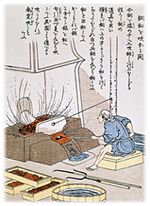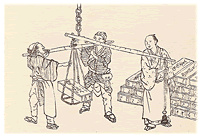Nanban-buki, also called nanban-shibori, is a refining technique in which lead is used to extract silver and other impurities from unrefined copper. First, unrefined copper containing silver is melted together with lead and cooled to form an alloy. Next, in order to separate the lead containing silver, the alloy is heated to a temperature at which lead melts but copper does not. The silver-containing lead is then heated on the ash, which absorbs the lead, leaving the silver. The use of the nanban-buki technique enables production of high-purity copper and recovery of silver.
Riemon Soga had heard from Europeans about the principle of separating silver from copper and, with great perseverance, he eventually developed the nanban-buki technique. This breakthrough was achieved in the Keicho era (1596-1615). Riemon made the technique available to others in the copper-casting guild of Osaka. Consequently, copper mined throughout Japan was sent to Osaka for refining.
Nanban-buki is a traditional technique that was used for some 300 years until the end of the 19th century. The technique is described in detail in the Kodo Zuroku (Illustrated Book on the Refining of Copper) issued by the House of Sumitomo at the beginning of the 19th century.

